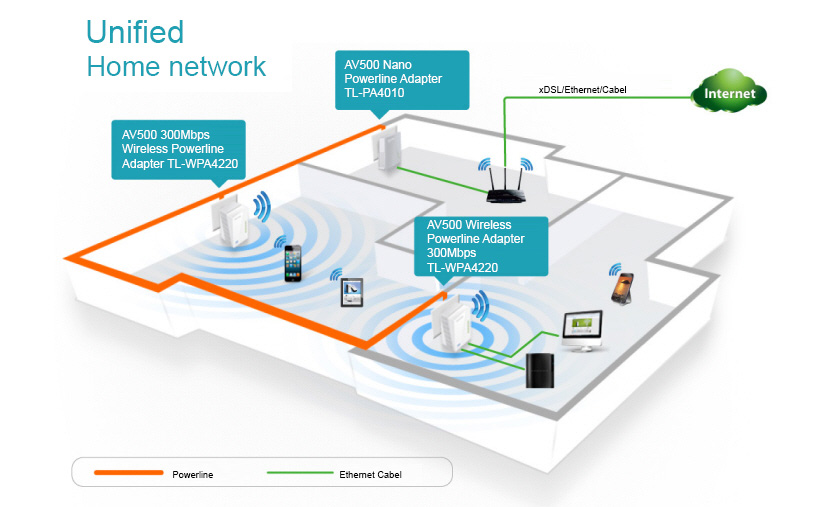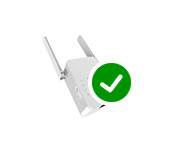Standard HomePlug AV and PowerLine Adaplers: What is it and How It Works?

Soon I’m going to write an instruction on how to set up a set of Powerline adapters (AV500 TL-WPA4220KIT) from TP-LINK, and I decided to prepare a small article to tell you what these Powerline adapters are, what they are, and how HomePlug AV technology works.
Most likely, you already know that the HomePlug AV standard makes it possible to transmit data through electrical wiring. With the help of special Powerline adapters, we can build a network where different devices will exchange data. Just like over wi-fi, or over a network cable. Only for data transmission in Powerline network we use electrical wiring, which is in every apartment, house or office. As a result, we get an internet connection from an outlet, all over the house.
This technology was developed at HomePlug Powerline Alliance. With PLC-technology (Power Line Communication/Carrier) you can transmit data over the power grid up to 300 meters. This is quite enough even for a large house.
HomePlug AV standards
There are two main standards. HomePlug AV and HomePlug AV2:
- HomePlug AV adapters can operate at different speeds. They can be: 200 Mbps (AV200), 500 Mbps (AV500) and 600 Mbps (AV600). The actual speed will of course be lower. Approximately 100, 240, and 280 Mbps. Be sure to take this into account when choosing PowerLine adapters. It all depends on what you will use the network for. If it is watching videos, online games, etc., it is better to choose the fastest adapters.
- HomePlug AV2 standard – speed up to 1200 Mbps. In real conditions, this speed is of course lower, about 600 Mbps. True, the new standard is very demanding on the quality of wiring, and grounding is required. To achieve this speed, it must be copper, and of very good quality.
How does the PowerLine network work, and for what purposes is it suitable?
I will try to explain everything as simply as possible. As I wrote above, with the help of special PowerLine adapters we can transmit data through the electrical wiring, which is laid in our house.
I will tell you by example. We have connected the Internet, and there is a router, or modem. Internet we need to stretch for example in some distant room, or on the second (third) floor. Where we will install another router, or connect the Internet to a computer, TV, IPTV set-top box, etc. This is quite a standard situation. You can proceed as follows:
- The first option: lay a regular network cable (twisted pair). This will give us a hot and stable connection. But, in most cases, laying a cable is not possible, or it is not very convenient.
- The second option: wireless connection between two routers, or use repeaters. But, again, wireless connection may not be very stable. And if everything works, there will be a decent loss in speed. In addition, you may need to install several repeaters, if the distance is large, or the signal will be poorly penetrated.
- Thethird option is to use these PowerLine adapters, which are the subject of this article. Near the router, or modem, we plug one of the adapters into the outlet, and connect them with a network cable. Then, in the rooms we need, we connect other adapters to the power grid, to which we can connect devices via network cable, or another router. Where necessary, you can install adapters that are able to distribute wi-fi. More precisely, to expand the coverage area of wi-fi, over the power grid.
It should be noted that a modem or router must be installed and configured. Since PowerLine adapters do not know how to establish a connection with the provider. They are created solely to expand the existing network.
I thought to draw a scheme of PowerLine network operation myself, but on the site of TP-LINK company I saw a very clear and beautiful scheme. I think the guys from TP-LINK won’t mind if I add it to the article.
You can buy as many adapters as you need. Where you need wi-fi, you can put HomePlug adapters with the ability to give out wireless. And in those rooms where you want to connect devices by cable, put the usual adapters with RJ-45 connector.
As you can see, everything is very simple. Setting up is just as simple. You can combine up to 64 adapters in one network. When choosing adapters, pay special attention to the number of RJ-45 ports, and the ability to distribute Wi-Fi network. You can also use HomePlug adapters from different manufacturers within one network. But I strongly advise you to use devices from the same manufacturer. At least because of the simplicity in configuration (pressing one button on all adapters).
Security. In this respect, everything is good. The HomePlug AV standard supports 128-bit AES encryption.
Minuses of HomePlug AV
In addition to all the above pluses, there are, of course, minuses. Now we will consider them:
- Electrical wiring. It should be of high quality. If the house has old wiring, low-quality cables, a lot of connections, it will affect the work of PowerLine network, and the speed.
- Some electrical appliances can interfere with the work of such a network. But, as practice shows, this is not a significant disadvantage. Unless at the moment of starting some device, there may be interference. But you are unlikely to notice them.
- The adapters themselves can also interfere with electrical devices. Mostly radio devices.
- Adapters do not work through power filters and stabilizers.
- HomePlug AV2 standard requires grounded wiring.
- All adapters must operate on the same phase. To connect adapters on different phases (if you have two phases), you can use a switch, or an interphase repeater. There are instructions on the internet for setting up such circuits.
If you have good wiring, and you know how it is organized, there will be no problems with the choice of PowerLine adapters and setting up the network.
Conclusions:
If you need to expand your Wi-Fi network to one or two rooms, and there are no problems with the load of the wireless channel, then it makes sense to buy an ordinary repeater. If it is possible to lay a network cable, it is the best option, in terms of speed and stability of the network. There will be no interference and other factors that can affect the network.
Well, Powerline networks also deserve attention, although they are not very popular. We are always scared of something new. We are too lazy to understand new solutions. I think because of this, many people prefer to use a regular cable or wi-fi to expand the network, rather than wiring. And for many people it looks kind of strange. How’s that, internet from a wall socket 🙂 .
And HomePlug AV technology is quite working, and already improved enough to use it in your home. Besides, the price for such devices is not very high.


 Smart Outlet with Wi-Fi. What it is?
Smart Outlet with Wi-Fi. What it is?  Seamless Wi-Fi. Fast Roaming (802.11r) in the Wi-Fi Mesh Systems Settings
Seamless Wi-Fi. Fast Roaming (802.11r) in the Wi-Fi Mesh Systems Settings  Wi-Fi Mesh System-What is it and love the fiture is for mesh networks?
Wi-Fi Mesh System-What is it and love the fiture is for mesh networks?  How to Choose a Wi-Fi Signal Amplifier? Best Wi-Fi Repiters for an Apartment or at Home
How to Choose a Wi-Fi Signal Amplifier? Best Wi-Fi Repiters for an Apartment or at Home